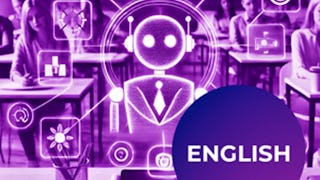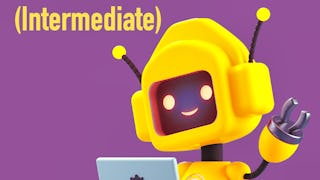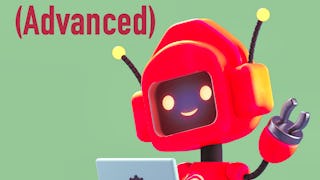Today’s learners need to know what artificial intelligence (AI) is, how it works, how to use it in their everyday lives, and how it could potentially be used in their future. Using AI requires skills and values which extend far beyond simply having knowledge about coding and technology.


Enjoy unlimited growth with a year of Coursera Plus for $199 (regularly $399). Save now.


Artificial Intelligence (AI) Education for Teachers


Instructors: Dr Anne Forbes
43,166 already enrolled
Included with
(941 reviews)
What you'll learn
Compare AI with human intelligence, broadly understand how it has evolved since the 1950s, and identify industry applications
Identify and use creative and critical thinking, design thinking, data fluency, and computational thinking as they relate to AI applications
Explain how the development and use of AI requires ethical considerations focusing on fairness, transparency, privacy protection and compliance
Describe how thinking skills embedded in Australian curricula can be used to solve problems where AI has the potential to be part of the solution
Skills you'll gain
- Computer Science
- Artificial Intelligence
- Computational Thinking
- Creativity
- Responsible AI
- Digital pedagogy
- Data Literacy
- Computer Programming
- Ethical Standards And Conduct
- Data Quality
- Design Thinking
- Data Ethics
- Algorithms
- Artificial Intelligence and Machine Learning (AI/ML)
- Data-Driven Decision-Making
- Machine Learning
Details to know

Add to your LinkedIn profile
15 assignments
See how employees at top companies are mastering in-demand skills

There are 6 modules in this course
In this module we'll introduce you to the course, tell you a little bit about why we think it's important that you and your students know about artificial intelligence (AI), and share with you some additional resources that might be useful.
What's included
2 videos8 readings1 assignment
In his book, “Make. Think. Imagine”, John Browne writes: “Artificial intelligence seems to be everywhere”. Some of its recent applications and achievements are well known; its potential to help build – or undermine – our civilisation is immense. As teachers, it’s hard for us to ignore this potential. AI is changing the tools we have at our disposal and adds to the impetus for a curriculum which incorporates the so-called "21st century skills". In this module, you will think about how AI may be defined, particularly in relation to human intelligence, and how it has taken different forms. You will consider how it has evolved over the last 70 years and come to show promise in so many different applications.
What's included
1 video17 readings4 assignments6 discussion prompts2 plugins
Both design thinking, and critical and creative thinking (CCT), embrace skills which are important for teams working to solve problems with AI. In design thinking, these skills include collaboration, solving a problem with constraints, coming up with an idea, testing it, and if necessary, going back to the drawing board. The process is iterative. As for CCT, creative thinking is required to identify opportunities for AI, and critical thinking can help us evaluate its application. In this module, you will learn about the key principles and stages in the design thinking process. You will consider CCT from the perspective of convergent and divergent thinking, de Bono's Six Hats, and ACARA's four quadrant model. Examples of "creative AI" will be examined to help us understand the barriers to machine creativity.
What's included
1 video21 readings3 assignments4 discussion prompts3 plugins
When it comes to computational thinking skills, there are two people who’ve been very influential in bringing them to the classroom. One is Seymour Papert who in the 1960s developed a computer program for children. The other influential person is Jeanette Wing, a data scientist, who wrote a short article advocating the use of computational thinking. In this module, you’ll appreciate that human or AI decision-making depends crucially on the quality of data. You’ll think about what data is, how it takes different forms and can be represented in different ways. Using the website, Machine Learning for Kids, we will look at what has been a classic problem in image recognition: being able to distinguish between cats and dogs. You’ll also learn about just what computational thinking is, its place in the Australian Curriculum, and the ideas and skills behind it. You’ll see how these skills can be developed with both “unplugged” and computer-based activities.
What's included
1 video20 readings4 assignments3 discussion prompts2 plugins
Back in the 1940s, one of the grand masters of science fiction, Isaac Asimov, introduced into his stories the "laws of robotics" which were designed to protect humans from wayward machines. While machine intelligence has not evolved in ways that Asimov could have foreseen, there is still a need to ensure that AI works for the good of society. In this module, we will explore some of the ethical issues associated with AI. We will look at a CSIRO framework to help deal with these issues. We will see that decisions or predictions based on AI can be just as biased and prejudicial as those made by human individuals and groups. The Human Rights Commission recently reported the results of a poll designed to garner support for a variety of protective measures (Hunter, F. 'Human Rights Commission warns government over “dangerous” use of AI.' SMH, August 15, 2020). For example, it might be considered important that people should know when a decision which affects them, has been made by computer and that they have the right to appeal against such a decision.
What's included
1 video12 readings3 assignments2 discussion prompts1 plugin
In this module we'll summarise the course, and remind you of some options you might like to utilise in your future teaching practice.
What's included
1 video2 readings1 discussion prompt
Instructors


Explore more from Education
 Status: Preview
Status: PreviewUniversity of Pennsylvania
 Status: Preview
Status: PreviewUniversità di Napoli Federico II
 Status: Preview
Status: PreviewKennesaw State University
 Status: Preview
Status: PreviewKennesaw State University
Why people choose Coursera for their career




Learner reviews
941 reviews
- 5 stars
78.21%
- 4 stars
16.68%
- 3 stars
3.29%
- 2 stars
0.42%
- 1 star
1.38%
Showing 3 of 941
Reviewed on Feb 19, 2025
Highly valuable course; thoroughly enjoyed; insightful; very sound resource links enabling extension of ideas; thought provoking.
Reviewed on Aug 18, 2021
Excellently designed program. Very informative. Provides excellent inputs on AI to the learners. A very useful program to all teachers.
Reviewed on Apr 6, 2024
This course is very wide-ranging in terms of the topics it covers and contains excellent information and practical activities for teachers to use with their students. I recommend it highly.
Frequently asked questions
This course is suitable for all teachers of students aged 5 through to 17 years. You do not need to be a STEM teacher to be able to do this course.
You can do this course at your own pace and in or out of sequence. Modules and topics can be done in the order they are presented in the course, or you can pick and choose the topics you are most interested in.
Primary school is the best time to introduce AI to learners. Early learning experiences with AI provide students with the knowledge, experience and confidence to tackle significant problems where AI solutions would be beneficial.
More questions
Financial aid available,







